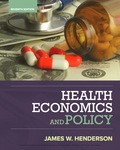
Subpart (a):
The preventive health care cost effectiveness.
Subpart (a):
Answer to Problem 3P
The total cost of 100 tests is $10,000. The total future medical expense averted is $15,000. The medical expense saved after setting up of the screening system is $5,000.
Explanation of Solution
The preventive health care measures are those medical precautionary measures which help the people to stay healthy and free from diseases. The screening system helps the people to easily identify and detect various diseases in their early stages which will help them to treat the diseases easily and affordably without much hassle.
The cost of one screening test is $100 according to the given information and the number of persons taking the screening test is 100. Thus, the total cost of taking the medical screening test can be calculated by multiplying the cost per screening test with the total number of persons taking the screening test as follows:
Thus, the total expense of 100 screening tests is $10,000.
The given percentage of persons having the test result positive is 15%. Thus, the total number of persons having positive test results can be calculated by multiplying the total number of persons with the given percentage as follows:
Thus, there will be 15 persons having the positive results from the screening test.
The amount of the future medical expense saved by the individual when the test result is positive is $1,000. Thus, the total future medical expense that can be saved by the people having the positive test results can be calculated by multiplying the per person medical expense saved with the total number of persons having positive test results as follows:
Thus, the total future medical expense saved by the persons having the positive test results is $15,000.
The cost of setting up the screening system is $10,000 and the total future medical expense saved is $15,000. Thus, the net future medical expense saved can be calculated by subtracting the cost of setting up the screening system from the total medical expense saved as follows:
Thus, the net medical expense saved after reducing the cost of setting up the screening test is $5,000.
Concept introduction:
Preventive health care: They are the measures taken in order to prevent the occurrence of a disease rather than treatment of a disease.
Sub part (b):
The net medical expense loss after reducing the cost of screening test.
Sub part (b):
Answer to Problem 3P
The total cost of 100 tests is $10,000. The total future medical expense averted is $5,000. The medical expense lost after setting up of the screening system is -$5,000.
Explanation of Solution
The cost of one screening test is $100 according to the given information and the number of persons taking the screening test is 100. Thus, the total cost of taking the medical screening test can be calculated by multiplying the cost per screening test with the total number of persons taking the screening test as follows:
Thus, the total expense for 100 screening tests is $10,000.
The given percentage of persons having the test result as positive is 5%. Thus, the total number of persons having positive test results can be calculated by multiplying the total number of persons with the given percentage as follows:
Thus, there will be 5 persons having the positive results from the screening test.
The amount of the future medical expense saved by the individual when the test result is positive is $1,000. Thus, the total future medical expense saved by the people having the positive test results can be calculated by multiplying the per person medical expense saved with the total number of persons having positive test results as follows:
Thus, the total future medical expense saved by the persons having the positive test results is $5,000.
The cost of setting up the screening system is $10,000 and the total future medical expense saved is $5,000. Thus, the net future medical expense saved can be calculated by subtracting the cost of setting up the screening system from the total medical expense saved as follows:
Since the result is having a negative sign, it shows that the expense of setting up the screening system is higher than the benefit received from the use of the screening system. Thus, the net result is a loss. Thus, the net medical expense loss after reducing the cost of setting up the screening test is -$5,000.
Want to see more full solutions like this?
Chapter 22 Solutions
Economics: Principles, Problems, & Policies (McGraw-Hill Series in Economics) - Standalone book
- 19. In a paragraph, no bullet, points please answer the question and follow the instructions. Give only the solution: Use the Feynman technique throughout. Assume that you’re explaining the answer to someone who doesn’t know the topic at all. How does the Federal Reserve currently get the federal funds rate where they want it to be?arrow_forward18. In a paragraph, no bullet, points please answer the question and follow the instructions. Give only the solution: Use the Feynman technique throughout. Assume that you’re explaining the answer to someone who doesn’t know the topic at all. Carefully compare and contrast fiscal policy and monetary policy.arrow_forward15. In a paragraph, no bullet, points please answer the question and follow the instructions. Give only the solution: Use the Feynman technique throughout. Assume that you’re explaining the answer to someone who doesn’t know the topic at all. What are the common arguments for and against high levels of federal debt?arrow_forward
- 17. In a paragraph, no bullet, points please answer the question and follow the instructions. Give only the solution: Use the Feynman technique throughout. Assume that you’re explaining the answer to someone who doesn’t know the topic at all. Explain the difference between present value and future value. Be sure to use and explain the mathematical formulas for both. How does one interpret these formulas?arrow_forward12. Give the solution: Use the Feynman technique throughout. Assume that you’re explaining the answer to someone who doesn’t know the topic at all. Show and carefully explain the Taylor rule and all of its components, used as a monetary policy guide.arrow_forward20. In a paragraph, no bullet, points please answer the question and follow the instructions. Give only the solution: Use the Feynman technique throughout. Assume that you’re explaining the answer to someone who doesn’t know the topic at all. What is meant by the Federal Reserve’s new term “ample reserves”? What may be hidden in this new formulation by the Fed?arrow_forward
- 14. In a paragraph, no bullet, points please answer the question and follow the instructions. Give only the solution: Use the Feynman technique throughout. Assume that you’re explaining the answer to someone who doesn’t know the topic at all. What is the Keynesian view of fiscal policy and why are some economists skeptical?arrow_forward16. In a paragraph, no bullet, points please answer the question and follow the instructions. Give only the solution: Use the Feynman technique throughout. Assume that you’re explaining the answer to someone who doesn’t know the topic at all. Describe a bond or Treasury security. What are its components and what do they mean?arrow_forward13. In a paragraph, no bullet, points please answer the question and follow the instructions. Give only the solution: Use the Feynman technique throughout. Assume that you’re explaining the answer to someone who doesn’t know the topic at all. Where does the government get its funds that it spends? What is the difference between federal debt and federal deficit?arrow_forward
- 11. In a paragraph, no bullet, points please answer the question and follow the instructions. Give only the solution: Use the Feynman technique throughout. Assume that you’re explaining the answer to someone who doesn’t know the topic at all. Why is determining the precise interest rate target so difficult for the Fed?arrow_forwardProblem 1 Regression Discontinuity In the beginning of covid, the US government distributed covid stimulus payments. Suppose you are interested in the effect of receiving the full amount of the first stimulus payment on the total spending in dollars by single individuals in the month after receiving the payment. Single individuals with annual income below $75,00 received the full amount of the stimulus payment. You decide to use Regression Discontinuity to answer this question. The graph below shows the RD model. 3150 3100 3050 Total Spending in the month after receiving the stimulus payment 2950 3000 74000 74500 75000 75500 76000 Annual income a. What is the outcome? (5 points) b. What is the treatment? (5 points) C. What is the running variable? (5 points) d. What is the cutoff? (5 points) e. Who is in the treatment group and who is in the control group? (10 points) f. What is the discontinuity in the graph and how do you interpret it? (10 points) g. Explain a scenario which can…arrow_forwardProblem 2 Difference-in-Difference In the beginning of 2005, Minnesota increased the sales tax on alcohol. Suppose you are interested in studying the effect of the increase in sale taxes on alcohol on the number of car accidents due to drinking in Minnesota. Unlike Minnesota, Wisconsin did not change the sales tax on alcohol. You decide to use a Difference-in-difference (DID) Model. The numbers of car accidents in each state at the end of 2004 and 2005 are as follows: Year Number of car accidents in Minnesota Number of car accidents in Wisconsin 2004 2000 2500 2005 2500 3500 a. Which state is the treatment state and which state is the control state? (10 points) b. What is the change in the outcome for the treatment group between 2004 and 2005? (5 points) C. Can we interpret the change in the outcome for the treatment group between 2004 and 2005 as the causal effect of the policy on car accidents? Explain your answer. (10 points) d. What is the change in the outcome for the control…arrow_forward

 Exploring EconomicsEconomicsISBN:9781544336329Author:Robert L. SextonPublisher:SAGE Publications, Inc
Exploring EconomicsEconomicsISBN:9781544336329Author:Robert L. SextonPublisher:SAGE Publications, Inc Economics (MindTap Course List)EconomicsISBN:9781337617383Author:Roger A. ArnoldPublisher:Cengage Learning
Economics (MindTap Course List)EconomicsISBN:9781337617383Author:Roger A. ArnoldPublisher:Cengage Learning

 Principles of Economics 2eEconomicsISBN:9781947172364Author:Steven A. Greenlaw; David ShapiroPublisher:OpenStax
Principles of Economics 2eEconomicsISBN:9781947172364Author:Steven A. Greenlaw; David ShapiroPublisher:OpenStax





